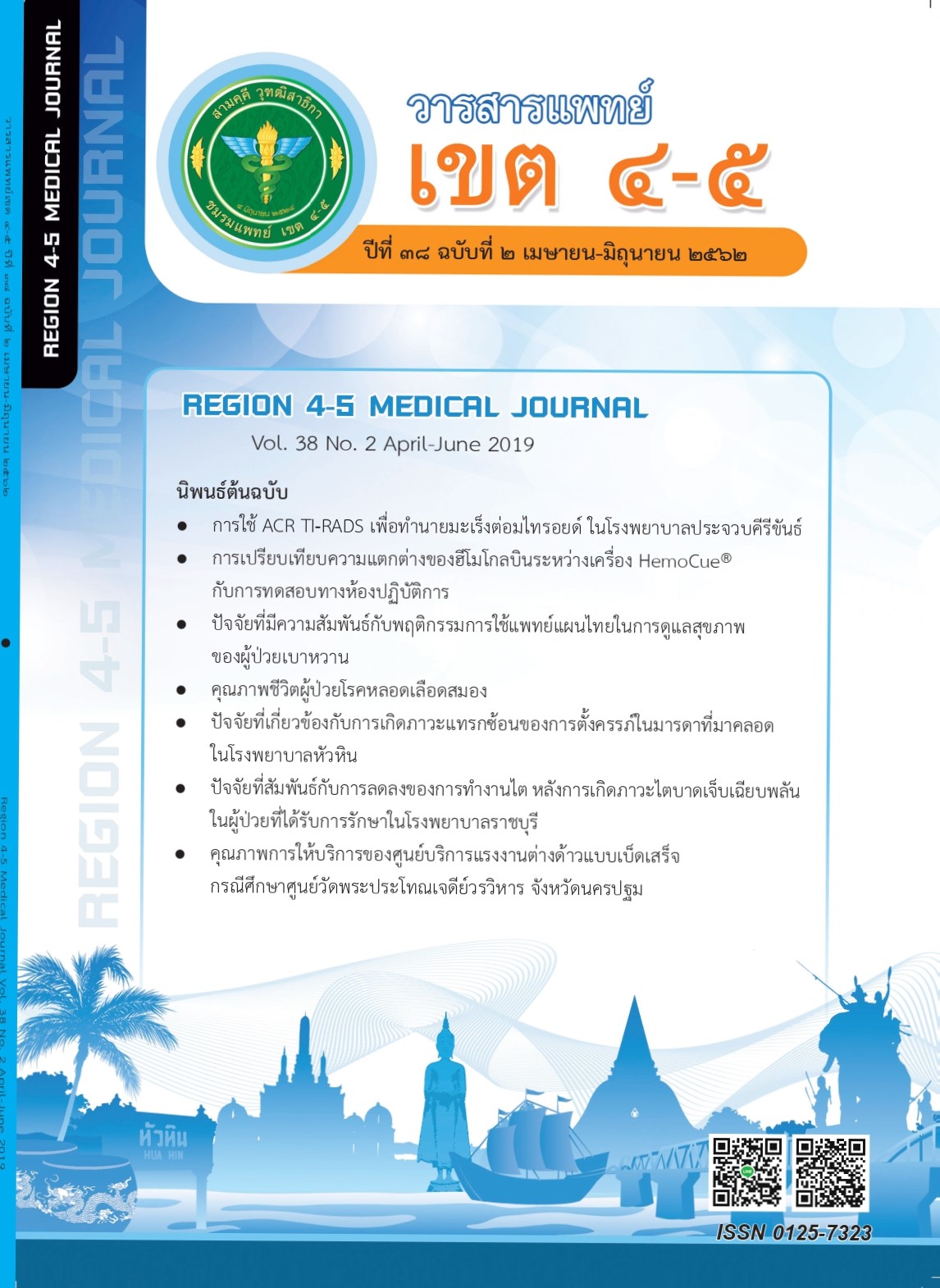ปัจจัยที่สัมพันธ์กับการสั่งยา angiotensin- converting enzyme inhibitors หรือ angiotensin receptor blockers และผลการชะลอไตเสื่อมของผู้ป่วยโรคไตเรื้อรัง ในโรงพยาบาลโพธาราม
คำสำคัญ:
โรคไตเรื้อรัง, angiotensin converting enzyme inhibitors, angiotensin receptor blockersบทคัดย่อ
วัตถุประสงค์: เพื่อศึกษาปัจจัยที่มีความสัมพันธ์กับการสั่งยา angiotensin–converting enzyme inhibitors (ACEI) หรือ angiotensin receptor blockers (ARB) และผลการชะลอไตเสื่อมของผู้ป่วยโรคไตเรื้อรัง ในโรงพยาบาลโพธาราม
วิธีการศึกษา: การศึกษาแบบย้อนหลัง โดยรวบรวมข้อมูลผู้ป่วยโรคไตเรื้อรังจากโปรแกรม HOSxP ระหว่างวันที่ 1 ตุลาคม 2561 ถึงวันที่ 30 กันยายน 2563 จำแนกกลุ่มผู้ป่วยออกตามระยะโรคไตเรื้อรัง อายุ โรคเบาหวาน โรคความดันโลหิตสูง ปริมาณโปรตีนในปัสสาวะ คลินิกที่เข้ารับบริการ จากนั้นวิเคราะห์อัตราส่วนและปัจจัยที่สัมพันธ์กับการสั่งยา ACEI หรือ ARB โดยวิธีวิเคราะห์ถดถอยพหุแบบลอจิสติค และเปรียบเทียบอัตราการกรองของไตระหว่างกลุ่มที่ได้ยาและไม่ได้ยา เมื่อสิ้นสุดการศึกษาเพื่อแสดงผลการชะลอไตเสื่อม
ผลการศึกษา: ผู้ป่วยทั้งหมด 3,994 ราย จำนวนที่ได้รับยา ACEI หรือ ARB 1,560 ราย (ร้อยละ 39) เมื่อแบ่งตามโรคไตเรื้อรังระยะ 1, 2, 3a, 3b, และ 4 อัตราส่วนที่ได้รับยาร้อยละ 48.5, 58.9, 40.5, 32.4 และ 15.9 ตามลำดับ ปัจจัยที่สัมพันธ์กับการสั่งยา ACEI หรือ ARB คือ โรคไตเรื้อรังระยะ 2 มีค่า odds ratio 1.39 (95% confidence interval (CI) 1.02 - 1.91, p = .04) โรคไตเรื้อรังระยะ 4 0.43 (95% CI 0.23 - 0.80, p = .01) โรคเบาหวาน 2.92 (95% CI 1.72 - 4.94, p < .001) โรคความดันโลหิตสูง 5.66 (95% CI 3.23 - 9.92, p < .001) โรคเบาหวานร่วมกับความดันโลหิตสูง 6.12 (95% CI 3.54 - 10.60, p < .001) และการเข้ารับบริการที่คลินิกเบาหวานหรือความดันโลหิตสูง 3.39 (95% CI 2.58 - 4.47, p < .001) ผลการชะลอไตเสื่อมในกลุ่มที่รับยา ACEI หรือ ARB มีอัตราการกรองของไตลดลงเฉลี่ย -5.58±9.06 มล./นาที/1.73ม.2/ปี กลุ่มไม่ได้ยามีอัตราการกรองของไตลดลงเฉลี่ย -6.64 ± 10.67 มล./นาที/1.73ม.2/ปี
สรุป: จากการศึกษาพบว่า กลุ่มผู้ป่วยโรคไตเรื้อรังที่ได้รับยา ACEI หรือ ARB สามารถชะลอไตเสื่อมได้ดีกว่า แต่อย่างไรก็ตามอัตราการใช้ยาของโรงพยาบาลโพธารามค่อนข้างต่ำ การใช้ยามีแนวโน้มลดลงในโรคไตเรื้อรังระยะท้าย โดยมีปัจจัยที่ส่งผลต่อการได้รับยา คือ โรคเบาหวาน โรคความดันโลหิตสูง และการเข้ารับบริการที่คลินิกเฉพาะโรค ดังนั้นจึงควรมีการพัฒนาเพื่อส่งเสริมการใช้ยาให้มากขึ้นในผู้ป่วยกลุ่มดังกล่าว
เอกสารอ้างอิง
2. คณะอนุกรรมการการลงทะเบียนการบำบัดทดแทนไตในประเทศไทย. Thailand renal replacement therapy: Year 2015. กรุงเทพฯ: สมาคมโรคไตแห่งประเทศไทย; 2558.
3. สมชาย เอี่ยมอ่อง, บรรณาธิการ. Text book of peritoneal dialysis. กรุงเทพฯ: เท็กซ์ แอนด์ เจอร์นัล พับลิเคชั่น; 2551.
4. เถลิงศักดิ์ กาญจน์บุษย์, บรรณาธิการ. Text book of peritoneal dialysis. กรุงเทพฯ: ศิริวัฒนาอินเตอร์ พริ้นท์; 2556.
5. Chapter 3: Management of progression and complications of CKD. Kidney Int Suppl (2011). 2013; 3(1):73–90. doi: 10.1038/kisup.2012.66
6. สมาคมโรคไตแห่งประเทศไทย. คำแนะนำสำหรับการดูแลผู้ป่วยโรคไตเรื้อรังก่อนการบำบัดทดแทนไต พ.ศ. 2558.
7. ตัวชี้วัดกระทรวงสาธารณสุข, สานักนโยบายและยุทธศาสตร์ กระทรวงสาธารณสุข. รายงานสถานการณ์ โควิด-19 [อินเทอร์เน็ต]. 2564 [เข้าถึงเมื่อ 16 ธันวาคม 2563]; เข้าถึงได้จาก: https://hdcservice.moph.go.th/hdc/main/index.php
8. คณะกรรมการการพัฒนาระบบที่ตอบสนองต่อปัญหาสุขภาพที่สำคัญ (สาขาไต). แนวทางพัฒนาระบบริการสุขภพ สาขาไต. กรุงเทพฯ: โรงพิมพ์ชุมชุนสหกรณ์การเกษตรแห่งประเทศไทย; 2556.
9. Chapter 1: Definition and classification of CKD. Kidney Int Suppl (2011). 2013;3(1):19–62.
10. Leehey DJ, Zhang JH, Emanuele NV, et al.; VA NEPHRON-D Study Group. BP and renal outcomes in diabetic kidney disease: the Veterans Affairs Nephropathy in Diabetes Trial. Clin J AmSoc Nephrol. 2015;10(12):2159–69. doi: 10.2215/CJN.02850315.
11. Summary of Recommendation Statements. Kidney Int Suppl (2011). 2012; 2(5): 341 - 2. doi: 10.1038/kisup.2012.50.
12. Robles NR, Romero B, de Vinuesa EG, et al. Treatment of proteinuria with lercanidipine associated with renin-angiotensin axis-blocking drugs. Ren Fail. 2010;32(2):192–7. doi: 10.3109/08860220903541135.
13. Parving HH, Lehnert H, Bröchner-Mortensen J, et al. The effect of irbesartan on the development of diabetic nephropathy in patients with type 2 diabetes. N Engl J Med. 2001;345(12):870–8. doi: 10.1056/NEJMoa011489.
14. Makino H, Haneda M, Babazono T, et al. The telmisartan renoprotective study from incipient nephropathy to overt nephropathy–rationale, study design, treatment plan and baseline characteristics of the incipient to overt: angiotensin II receptor blocker, telmisartan, Investigation on Type 2 Diabetic Nephropathy (INNOVATION) Study. J Int Med Res. 2005;33(6):677–86. doi: 10.1177/147323000503300610.
15. Effects of ramipril on cardiovascular and microvascular outcomes in people with diabetes mellitus: results of the HOPE study and MICRO-HOPE substudy. Heart Outcomes Prevention Evaluation Study Investigators [published correction appears in Lancet 2000 Sep 2;356(9232):860]. Lancet. 2000;355(9200):253–9.
16. Lewis EJ, Hunsicker LG, Clarke WR, et al. Renoprotective effect of the angiotensin-receptor antagonist irbesartan in patients with nephropathy due to type 2 diabetes. N Engl J Med. 2001;345(12):851–60. doi: 10.1056/NEJMoa011303.
17. Brenner BM, Cooper ME, de Zeeuw D, et al. Effects of losartan on renal and cardiovascular outcomes in patients with type 2 diabetes and nephropathy. N Engl J Med. 2001;345(12):861–9. Doi: 10.1056/NEJMoa011161
18. Strippoli GF, Bonifati C, Craig M, et al. Angiotensin converting enzyme inhibitors and angiotensin II receptor antagonists for preventing the progression of diabetic kidney disease. Cochrane Database Syst Rev. 2006;2006(4):CD006257. doi: 10.1002/14651858.CD006257.
19. American Diabetes Association. 11. Microvascular Complications and Foot Care: Standards of Medical Care in Diabetes–2021. Diabetes Care. 2021;44(Suppl 1):S151–S167.
20. Alvarez M, Ardiles L. Prescripción de fármacos bloqueadores del sistema renina angiotensina en pacientes con enfermedad renal crónica etapa 3 en atención primaria de salud [Prescription of renin-angiotensin-aldosterone system blockers in patients with stage 3 chronic kidney disease]. Rev Med Chil. 2019;147(2):173–80. doi: 10.4067/s0034-98872019000200173
21. Wang PT, Huang YB, Lin MY, et al. Prescriptions for angiotensin-converting enzyme inhibitors/angiotensin receptor blockers and monitoring of serum creatinine and potassium in patients with chronic kidney disease. Kaohsiung J Med Sci. 2012;28(9):477–83. doi: 10.1016/j.kjms.2012.04.004.
22. Winkelmayer WC, Fischer MA, Schneeweiss S, et al. Underuse of ACE inhibitors and angiotensin II receptor blockers in elderly patients with diabetes. Am J Kidney Dis. 2005;46(6):1080–7. doi: 10.1053/j.ajkd.2005.08.018.
23. Rosen AB, Karter AJ, Liu JY, et al. Use of angiotensin-converting enzyme inhibitors and angiotensin receptor blockers in high-risk clinical and ethnic groups with diabetes. J Gen Intern Med. 2004;19(6):669–75. doi: 10.1111/j.1525–1497.2004.30264.x.
24. ประภา พิทักษา, ธิญญรัตน์ ประสานนิษฐ์. ปัจจัยที่มีผลต่อการได้รับยากลุ่ม Angiotensin Converting Enzyme Inhibitor (ACEI) หรือ Angiotensin Receptor Blocker (ARB) ในผู้ป่วยเบาหวาน ของโรงพยาบาลกันทรลักษ์ จังหวัดศรีสะเกษ. วารสารเภสัชกรรมไทย 2558;7(1):121–9.
25. Bakris GL, Weir MR. Angiotensin-converting enzyme inhibitor-associated elevations in serum creatinine: is this a cause for concern?. Arch Intern Med. 2000;160(5):685–93. doi: 10.1001/archinte.160.5.685.
26. Schwenger V, Ritz E. Audit of antihypertensive treatment in patients with renal failure. Nephrol Dial Transplant. 1998;13(12):3091–5. doi: 10.1093/ndt/13.12.3091.
ดาวน์โหลด
เผยแพร่แล้ว
รูปแบบการอ้างอิง
ฉบับ
ประเภทบทความ
สัญญาอนุญาต
ลิขสิทธิ์บทความเป็นของผู้เขียนบทความ แต่หากผลงานของท่านได้รับการพิจารณาตีพิมพ์ลงวารสารแพทย์เขต 4-5 จะคงไว้ซึ่งสิทธิ์ในการตีพิมพ์ครั้งแรกด้วยเหตุที่บทความจะปรากฎในวารสารที่เข้าถึงได้ จึงอนุญาตให้นำบทความในวารสารไปใช้ประโยชน์ได้ในเชิงวิชาการโดยจำเป็นต้องมีการอ้างอิงถึงชื่อวารสารอย่างถูกต้อง แต่ไม่อนุญาตให้นำไปใช้ในเชิงพาณิชย์




